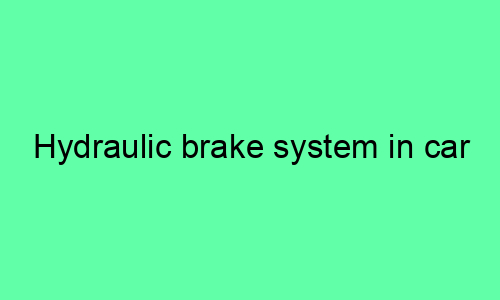## HTML Post on Hydraulic Brake System in Cars
### Introduction
The hydraulic brake system is a crucial component in ensuring the safe operation of automobiles. It enables the driver to control the vehicle’s speed and stop it effectively. This article delves into the intricate details of the hydraulic brake system, covering its components, operation, advantages, and maintenance.
### Components of a Hydraulic Brake System
The hydraulic brake system consists of several key components:
– **Master Cylinder:** The master cylinder is the heart of the brake system. It converts the force applied by the driver’s foot on the brake pedal into hydraulic pressure.
– **Brake Lines:** Brake lines are flexible, high-pressure pipes that transmit the hydraulic fluid from the master cylinder to the wheels.
– **Brake Calipers:** Brake calipers are located at each wheel. They contain pistons that push against brake pads to generate friction and slow down the wheels.
– **Brake Pads:** Brake pads are made of a special friction material that provides the necessary grip to stop the wheels.
– **Brake Rotors:** Brake rotors are metal discs attached to the wheels. They provide a smooth surface for the brake pads to grip against.
– **Brake Fluid:** Brake fluid is a hydraulic fluid that transfers pressure throughout the system. It must withstand high temperatures and remain stable under various conditions.
### Operation of the Hydraulic Brake System
The operation of the hydraulic brake system is relatively straightforward:
1. **Driver Input:** When the driver presses the brake pedal, force is transferred to the master cylinder.
2. **Hydraulic Pressure Generation:** The master cylinder uses the force to generate hydraulic pressure in the brake lines.
3. **Transmission of Pressure:** The brake fluid transmits the pressure from the master cylinder to the brake calipers at each wheel.
4. **Activation of Calipers:** The hydraulic pressure pushes the pistons in the brake calipers, which in turn force the brake pads against the brake rotors.
5. **Friction and Stopping:** The friction between the brake pads and rotors slows down and eventually stops the vehicle.
### Advantages of a Hydraulic Brake System
The hydraulic brake system offers several advantages:
– **High Efficiency:** Hydraulic systems efficiently transfer force and create high braking power.
– **Responsiveness:** The system responds quickly to the driver’s input, providing immediate braking action.
– **Reliability:** Hydraulic systems are generally reliable due to the enclosed and sealed nature of the components.
– **Heat Dissipation:** Brake pads and rotors absorb and dissipate heat during braking, reducing the risk of overheating.
– **Compact Size:** The components of the hydraulic brake system are relatively small, allowing for efficient packaging in vehicles.
### Maintenance of a Hydraulic Brake System
Regular maintenance is crucial for the optimal performance and safety of the hydraulic brake system:
– **Brake Fluid Changes:** Brake fluid should be replaced every 2-3 years to maintain its properties and prevent moisture accumulation.
– **Brake Pad Inspection:** Brake pads should be inspected regularly for wear and replaced as necessary to ensure adequate stopping power.
– **Brake Rotor Inspection:** Brake rotors should be checked for excessive wear, warping, or damage.
– **Brake Line Inspection:** Brake lines should be inspected for leaks, corrosion, or damage and replaced if necessary.
– **Calipers Inspection:** Brake calipers should be inspected for proper operation and any signs of leakage or damage.
### Advanced Hydraulic Brake Systems
Automakers have developed advanced hydraulic brake systems to further enhance safety and performance:
– **Anti-Lock Braking System (ABS):** ABS prevents the wheels from locking during braking, maintaining vehicle stability and control.
– **Electronic Brake Distribution (EBD):** EBD optimizes braking force distribution between the front and rear wheels.
– **Brake Assist (BA):** BA detects emergency braking situations and provides additional braking power to improve stopping distances.
### Conclusion
The hydraulic brake system in cars is an essential safety feature that enables the driver to control the vehicle’s speed and stop it effectively. Understanding the components, operation, advantages, and maintenance of the hydraulic brake system is crucial for ensuring the safety and reliability of your vehicle. Regular maintenance and the use of advanced braking technologies help optimize the performance and safety of the hydraulic brake system in modern cars.






